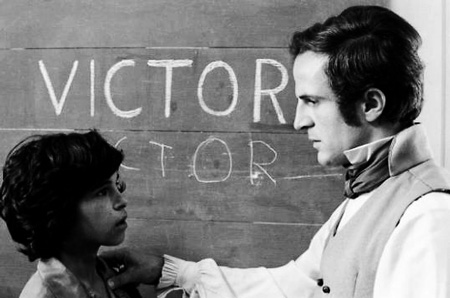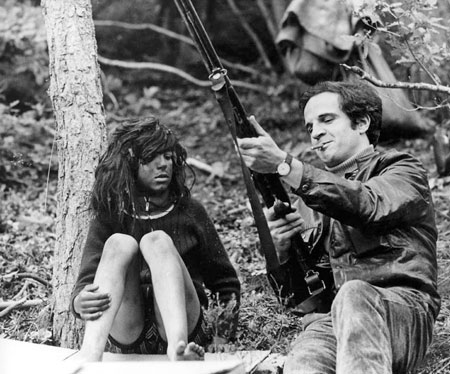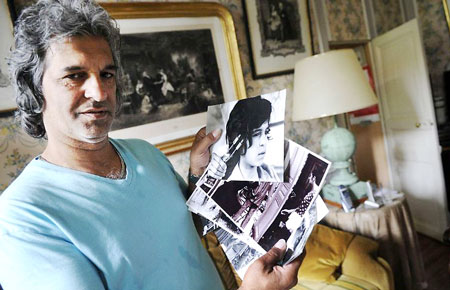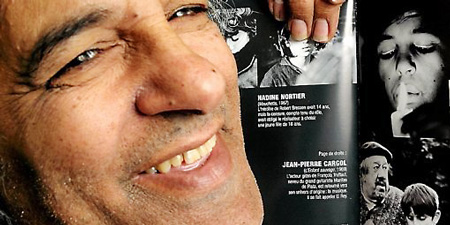A true story that inspired the
Nouvelle Vague director François Truffaut
Poster of the movie "the wild child"
The year is 1798, and farmers in the south of France, precisely Saint-Sernin-sur-Rance in Aveyron, on the hunt for a predator, instead find a naked young boy, presumably grown up in the wild without human contact. As the latest sensation, he's paraded before fee-paying gawkers at the Institute for the Deaf and Dumb, in Paris, while Dr. Itard—played by François Truffaut himself—debates with a colleague: is the boy a purely natural human, a tabula rasa, or simply an idiot? Itard takes the boy into his own home in an attempt to educate and civilize him.
Based on an actual case, and with its voiceover narration—an adaptation of Itard's two reports into diary form—, this is Truffaut's nearest approach to documentary. As l'enfant sauvage, Jean-Pierre Cargol, a Gypsy boy picked from over 2,500 hopefuls, is alternately ferocious and docile, while as Dr. Itard, Truffaut is superb. Cast partly because he realized he'd be directing the boy within the film, Truffaut imposed on himself a 'no smiling' rule—he lapses briefly once—to attain a kind of gravity, but then this only reinforces his ruthlessly unsentimental treatment of potentially treacly material, even as the inevitable question 'Was it worth it?' arises.
The movie plot
The film opens with the statement: "This story is authentic: it opens in 1798 in a French forest."

One summer day in 1798, a naked boy eleven or twelve years of age—Jean-Pierre Cargol—is found in a forest in the rural district of Aveyron in southern France. A woman sees him, then runs off screaming. She finds some hunters and tells them that she saw a wild boy. They hunt him down with a pack of dogs. The dogs, upon picking up the boy's scent, chase him up a tree. A branch breaks off, and the dogs attack him when he falls. He fights them off leaving one wounded, then continues to flee and hides in a hole. The dogs continue to follow his scent, eventually finding his hiding hole. The hunters arrive and force him out of the hole using smoke to cut off his air supply. After he emerges, the men grab him.

Living like a wild animal and unable to speak or understand language, the child has apparently grown up in solitude in the forest since an early age. He is brought to Paris and initially placed in a school for "deaf-mutes". Dr. Jean-Marc Gaspard Itard observes the boy and believes that he is neither deaf nor, as some of his colleagues believe, an "idiot". Itard thinks the boy's behaviour is a result of his deprived environment, and that he can be educated. Itard takes custody of the boy, whom he eventually names Victor, and removes him to his house on the outskirts of Paris. There, under the patient tutelage of the doctor and his housekeeper, Victor gradually becomes socialized and acquires the rudiments of language.
There is a narrow margin between the laws of civilization in rough Parisian life and the brutal laws of life in nature. Victor finds a sort of equilibrium in the windows that mark the transition between the closed interiors and the world outside. But he gains his ability to have social relations by losing his capacity to live as a savage.
The 1970 movie "L'enfant Sauvage" released in north America under the title "The Wild Child".
It is shown here in its original French version with English subtitles.
Jean-Pierre Cargol, the Wild Child actually grew up among
the world-best Gypsy guitar players
The shaggy hero who played back then still haunts Jean-Pierre Cargol's memories, even now.
François Truffaut sought for his 'Wild Child' in dance school first, because he wanted him to be flexible in his body movements. But the children he encountered got not enough tame tempers. He thought about a young Gypsy then. In May 1969, at the yearly Gypsy pilgrimage to Saintes-Maries-de-la-Mer, he noticed a very dark-haired boy. Jean-Pierre got picked during the final casting, and brought up to the filming set a few months later.
"I knew Truffaut chose me because I had the same eyes as him, just like his favourite actor Jean-Pierre Léaud", according to Jean-Pierre Cargol. His mane got whiter but his eyes are still maliciously piercing. He now lives at Montpellier, in the southern France.
At the age of 11, Jean-Pierre did not understand all the strange story of the savage discovered in the woods of Aveyron. However the film set definitely fascinated him. He recounts: "When you live an experience like that, you cannot forget it. There were some unpleasant moments, like the wig and the fake nails, the foam coated on my body, but moreover the nudity. You know I was very shy, I could not do it." Even though the good memories prevail. He enjoyed the close partnership when working with Truffaut. For the first time in his films Truffaut played, as he wanted to be close to the wild child, reassuring him.
Jean-Pierre Cargol, Manitas de Plata's nephew

When talking about Truffaut, Cargol reminds: "He gave me a camera. He was a truly great man. He was patient and spared me. The first shot was often the good one." Jean-Pierre Cargol remembers the discrete visits of Catherine Deneuve on the sets, she was then quite close to Truffaut. The shooting took place at Aubiat, three hours up north of Saint-Sernin sur Rance, close by Clermont-Ferrand, in the Puy-de-Dôme area and he was chaperoned by his mother. His father, was a little more distant. He was the famous Gypsy guitarist Hippolyte Baliardo, brother of Manitas de Plata. Jean-Pierre nickname is 'El Rey', but his real name is Baliardo. He recounts: "My father had played before the first screening of the film at the Régent cinema at Montpellier." This is why it was impossible for Jean-Pierre not to be a guitarist. He took the name of 'El Rey'—The King—but without crown or kingdoms as he likes to add.
He has long led the nights of Camargue, playing at Aigues-Mortes, and played with other Gypsy bands.

And filming one could ask? He regrets he did not film more. In 1976, Truffaut is at Montpellier filming "L'homme qui aimait les femmes"—The Man Who Loved Women—but there's no role for him. Then, time flies.
However there might be a project putting the wild child, now six times grandfather, back under the eye of the camera. He worked on a screenplay, with his friend photographer Eric de Hullessen, featuring the Gypsy community. Already, he's got the title: "The Baron", it's a nickname denoting a highly respected character in the Gypsy community. As well he is an active member of the (Christian) Pentecotist religious movement to which he converted himself a few years back.
Banner top photo: Saint-Sernin-sur-Rance, south Aveyron




